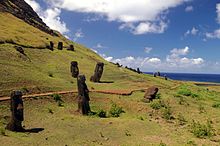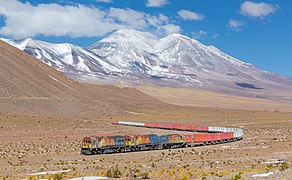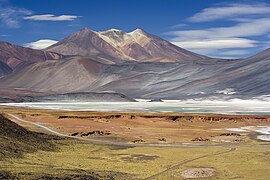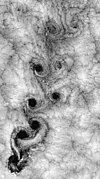| Main page | Assessment | Articles | Templates | Translation | Noticeboard | To Do List | Portal |
The Chile Portal

Chile, officially the Republic of Chile, is a country in western South America. It is the southernmost country in the world and the closest to Antarctica, stretching along a narrow strip of land between the Andes Mountains and the Pacific Ocean. With an area of 756,102 square kilometers (291,933 sq mi) and a population of 17.5 million as of 2017, Chile shares borders with Peru to the north, Bolivia to the northeast, Argentina to the east, and the Drake Passage to the south. The country also controls several Pacific islands, including Juan Fernández, Isla Salas y Gómez, Desventuradas, and Easter Island, and claims about 1,250,000 square kilometers (480,000 sq mi) of Antarctica as the Chilean Antarctic Territory. The capital and largest city of Chile is Santiago, and the national language is Spanish.
Spain conquered and colonized the region in the mid-16th century, replacing Inca rule, but failed to conquer the independent Mapuche people who inhabited what is now south-central Chile. Chile emerged as a relatively stable authoritarian republic in the 1830s after their 1818 declaration of independence from Spain. During the 19th century, Chile experienced significant economic and territorial growth, putting an end to Mapuche resistance in the 1880s and gaining its current northern territory in the War of the Pacific (1879–83) by defeating Peru and Bolivia. In the 20th century, up until the 1970s, Chile underwent a process of democratization and experienced rapid population growth and urbanization, while relying increasingly on exports from copper mining to support its economy. During the 1960s and 1970s, the country was marked by severe left-right political polarization and turmoil, which culminated in the 1973 Chilean coup d'état that overthrew Salvador Allende's democratically elected left-wing government. This was followed by a 16-year right-wing military dictatorship under Augusto Pinochet, which resulted in more than 3,000 deaths or disappearances. The regime ended in 1990, following a referendum in 1988, and was succeeded by a center-left coalition, which ruled until 2010.
Chile has a high-income economy and is one of the most economically and socially stable nations in South America, leading Latin America in competitiveness, per capita income, globalization, peace, and economic freedom. Chile also performs well in the region in terms of sustainability of the state and democratic development, and boasts the second lowest homicide rate in the Americas, following only Canada. Chile is a founding member of the United Nations, the Community of Latin American and Caribbean States (CELAC), and the Pacific Alliance, and joined the OECD in 2010. (Full article...)
Fueguino is a volcanic field in Chile. The southernmost volcano in the Andes, it lies on Tierra del Fuego's Cook Island and also extends over nearby Londonderry Island. The field is formed by lava domes, pyroclastic cones, and a crater lake.
Volcanic activity at Fueguino is part of the Austral Volcanic Zone, which is formed by the subduction of the Antarctic Plate beneath the South America Plate. The subducting plate has not reached a depth sufficient for proper volcanic arc volcanism, however. (Full article...)Selected biography -
Augusto José Ramón Pinochet Ugarte (25 November 1915 – 10 December 2006) was a Chilean army officer and military dictator who ruled Chile from 1973 to 1990. He was the leader of the military junta from 1973 to 1981, and was declared President of the Republic by the junta in 1974 and thus became the dictator of Chile, and from 1981 to 1990 as de jure president after a new constitution which confirmed him in the office was approved by a referendum in 1980. His time in office remains the longest of any Chilean ruler.
Augusto Pinochet rose through the ranks of the Chilean Army to become General Chief of Staff in early 1972 before being appointed its Commander-in-Chief on 23 August 1973 by President Salvador Allende. On 11 September 1973,
Pinochet seized power in Chile in a military coup, with the support of the United States, that toppled Allende's democratically elected left-wing Unidad Popular government and ended civilian rule. In December 1974, the ruling military junta appointed Pinochet Supreme Head of the nation by joint decree, although without the support of one of the coup's instigators, Air Force General Gustavo Leigh. After his rise to power, Pinochet persecuted leftists, socialists, and political critics, resulting in the executions of 1,200 to 3,200 people, the internment of as many as 80,000 people, and the torture of tens of thousands. According to the Chilean government, the number of executions and forced disappearances was at least 3,095. Operation Condor, a U.S.-supported terror operation focusing on South America, was founded at the behest of the Pinochet regime in late November 1975, his 60th birthday. (Full article...)Selected article -
Easter Island (Spanish: Isla de Pascua [ˈisla ðe ˈpaskwa]; Rapa Nui: Rapa Nui) is an island and special territory of Chile in the southeastern Pacific Ocean, at the southeasternmost point of the Polynesian Triangle in Oceania. The island is most famous for its nearly 1,000 extant monumental statues, called moai, which were created by the early Rapa Nui people. In 1995, UNESCO named Easter Island a World Heritage Site, with much of the island protected within Rapa Nui National Park.
Experts disagree on when the island's Polynesian inhabitants first reached the island. While many in the research community cited evidence that they arrived around the year 800, a 2007 study found compelling evidence that they arrived closer to 1200. The inhabitants created a thriving and industrious culture, as evidenced by the island's numerous enormous stone moai and other artifacts. But land clearing for cultivation and the introduction of the Polynesian rat led to gradual deforestation. By the time of European arrival in 1722, the island's population was estimated to be 2,000 to 3,000. European diseases, Peruvian slave raiding expeditions in the 1860s, and emigration to other islands such as Tahiti further depleted the population, reducing it to a low of 111 native inhabitants in 1877. (Full article...)General images
Did you know (auto generated)

- ... that Salar de Pedernales in Chile features dark slope streaks resembling dark slope streaks on Mars?
- ... that Peruvian foreign minister Manuel María Gálvez Egúsquiza was arrested by Chilean troops for refusing to sign peace with the cession of territory during the War of the Pacific?
- ... that Angelito de Canal 13, the mascot of the Chilean television network Canal 13, was inspired by its creator's son?
- ... that the Peruvian Civil Guard officer Mariano Santos Mateo was nicknamed the Brave Man of Tarapacá because he captured a banner of a Chilean military unit during the Battle of Tarapacá?
- ... that the Chile Ridge has a slab window?
- ... that Earle M. Chiles, a businessman and philanthropist from Portland, Oregon, was also a senator of the board of Ludwig Maximilian University in Munich, Germany?
Topics
Categories
Recognized content
| This is a list of recognized content, updated weekly by JL-Bot (talk · contribs) (typically on Saturdays). There is no need to edit the list yourself. If an article is missing from the list, make sure it is tagged (e.g. {{WikiProject Chile}}) or categorized correctly and wait for the next update. See WP:RECOG for configuration options. |
Featured articles
- Chilean battleship Almirante Latorre
- Almirante Latorre-class battleship
- Cerro Azul (Chile volcano)
- Calabozos
- El Tatio
- Chilean cruiser Esmeralda (1883)
- Guallatiri
- Laguna del Maule (volcano)
- Mothers of the Disappeared
- Ojos del Salado
- Pali-Aike volcanic field
- Pisco sour
- South American dreadnought race
- Taapaca
Good articles
- 2010 Pichilemu earthquakes
- 2018 Santiago ePrix
- Agustín Ross Cultural Centre
- Angata
- Los Ángeles Negros
- Apacheta-Aguilucho volcanic complex
- Argentine–Chilean naval arms race
- Atamu Tekena
- Orlando Bosch
- Lorenza Böttner
- Sara Braun
- Monte Burney
- Battle of Caldera Bay
- Felipe Camiroaga
- Chilean battleship Capitán Prat
- Carménère
- José María Caro Martínez
- Chile at the 2014 Winter Paralympics
- Coat of arms of Pichilemu
- Dutch expedition to Valdivia
- El Laco
- Milton Friedman
- Fueguino
- Mount Hudson
- Irruputuncu
- Laguna Miscanti
- Laguna del Negro Francisco
- Lascar (volcano)
- Lastarria
- Lazufre
- Licancabur
- Licancabur Lake
- Llullaillaco
- Nevado de Longaví
- Manuel Foster Observatory
- Monturaqui
- Irene Morales
- John Thomas North
- Obligation to Negotiate Access to the Pacific Ocean
- Olca-Paruma
- USS Oneota (1864)
- La Pacana
- Parinacota (volcano)
- Patio 29
- Pichilemu
- Colegio de la Preciosa Sangre de Pichilemu
- Salar de Punta Negra
- Reclus (volcano)
- Murders of María José Reyes and Juan Duarte
- Sammis Reyes
- Riro Kāinga
- Sairecabur
- Salar Ignorado
- San Pedro (Chile volcano)
- Socompa
- Sollipulli
- Tacora
- Tilocálar
- Nevado Tres Cruces
- Tupungatito
- Tuyajto Lake
Featured pictures
-
360-degree Panorama of the Southern Sky edit
-
A 360 degree panorama of a unique cloudscape over La Silla
-
Culpeo MC
-
FCAB EMD GT22CU-3 San Pedro - Ascotan
-
Laguna Miñiques, Chile, 2016-02-08, DD 33-38 PAN
-
Laser Towards Milky Ways Centre
-
Miscanti Lagoon near San Pedro de Atacama Chile Luca Galuzzi 2006
-
Moai Rano raraku
-
SQM GE 289A Boxcab Carmelita - Reverso
-
Volcán San Pedro, Chile, 2016-02-09, DD 18
-
Vortex-street-1
WikiProjects
Related portals
New articles
Rules | Match log | Results page (for watching) | Last updated: 2024-04-23 19:57 (UTC)
Note: The list display can now be customized by each user. See List display personalization for details.
- Carlos Miró-Quesada Laos (edit | talk | history | links | watch | logs | tools) by AlejandroFC (talk · contribs · new pages (48)) started on 2024-04-23, score: 23
- Uriel Canjura (edit | talk | history | links | watch | logs | tools) by Zoglophie (talk · contribs · new pages (7)) started on 2024-04-22, score: 20
- Mauro Siergiejuk (edit | talk | history | links | watch | logs | tools) by ImSnot (talk · contribs · new pages (34)) started on 2024-04-22, score: 23
- Franco Olego (edit | talk | history | links | watch | logs | tools) by ImSnot (talk · contribs · new pages (34)) started on 2024-04-22, score: 55
- Carex molinae (edit | talk | history | links | watch | logs | tools) by Hughesdarren (talk · contribs · new pages (6)) started on 2024-04-21, score: 31
- Albano Becica (edit | talk | history | links | watch | logs | tools) by ImSnot (talk · contribs · new pages (34)) started on 2024-04-21, score: 35
- Onffroy de Verez family (edit | talk | history | links | watch | logs | tools) by Alenglin (talk · contribs · new pages (4)) started on 2024-04-20, score: 20
- 2024 Challenger Concepción (edit | talk | history | links | watch | logs | tools) by Adamtt9 (talk · contribs · new pages (38)) started on 2024-04-19, score: 43
- Canal 13 (Chilean TV network) (edit | talk | history | links | watch | logs | tools) by FrederickEvans (talk · contribs · new pages (25)) started on 2024-04-19, score: 91
- Roberto Hernández (Uruguayan footballer) (edit | talk | history | links | watch | logs | tools) by ImSnot (talk · contribs · new pages (34)) started on 2024-04-18, score: 23
- Al sur del corazón (edit | talk | history | links | watch | logs | tools) by Telenovelafan215 (talk · contribs · new pages (9)) started on 2024-04-18, score: 31
- Ángel Cayetano (edit | talk | history | links | watch | logs | tools) by ImSnot (talk · contribs · new pages (34)) started on 2024-04-17, score: 23
- Deaths in January 1988 (edit | talk | history | links | watch | logs | tools) by Mill 1 (talk · contribs · new pages (6)) started on 2024-04-17, score: 14
- Maximiliano Rueda (edit | talk | history | links | watch | logs | tools) by ImSnot (talk · contribs · new pages (34)) started on 2024-04-17, score: 23
- Metharme lanata (edit | talk | history | links | watch | logs | tools) by Tom Radulovich (talk · contribs · new pages (148)) started on 2024-04-17, score: 31
- Franco García (edit | talk | history | links | watch | logs | tools) by ImSnot (talk · contribs · new pages (34)) started on 2024-04-16, score: 23
- Guillermo Kuschel (edit | talk | history | links | watch | logs | tools) by Avocadobabygirl (talk · contribs · new pages (4)) started on 2024-04-16, score: 31
- Ezequiel Naya (edit | talk | history | links | watch | logs | tools) by ImSnot (talk · contribs · new pages (34)) started on 2024-04-16, score: 23
- Franco Torres (edit | talk | history | links | watch | logs | tools) by ImSnot (talk · contribs · new pages (34)) started on 2024-04-16, score: 23
- January 1978 (edit | talk | history | links | watch | logs | tools) by Mandsford (talk · contribs · new pages (1)) started on 2024-04-16, score: 14
- Álvaro Cazula (edit | talk | history | links | watch | logs | tools) by ImSnot (talk · contribs · new pages (34)) started on 2024-04-16, score: 23
- Lucas Abascia (edit | talk | history | links | watch | logs | tools) by ImSnot (talk · contribs · new pages (34)) started on 2024-04-16, score: 23
- Thomas Gillier (edit | talk | history | links | watch | logs | tools) by Xelo16 (talk · contribs · new pages (1)) started on 2024-04-16, score: 37
- Marco Campagnaro (edit | talk | history | links | watch | logs | tools) by ImSnot (talk · contribs · new pages (34)) started on 2024-04-16, score: 23
- Cristián Aspillaga (edit | talk | history | links | watch | logs | tools) by Pietaster (talk · contribs · new pages (36)) started on 2024-04-16, score: 31
- Facundo Krüger (edit | talk | history | links | watch | logs | tools) by ImSnot (talk · contribs · new pages (34)) started on 2024-04-16, score: 43
- Claudio Vicuña Subercaseaux (edit | talk | history | links | watch | logs | tools) by Kapollajdi (talk · contribs · new pages (1)) started on 2024-04-16, score: 49
- Bruno Pérez (edit | talk | history | links | watch | logs | tools) by ImSnot (talk · contribs · new pages (34)) started on 2024-04-16, score: 43
- Dignitas Infinita (edit | talk | history | links | watch | logs | tools) by MikeCongo (talk · contribs · new pages (2)) started on 2024-04-09, score: 14
- Enzo Hoyos (edit | talk | history | links | watch | logs | tools) by ImSnot (talk · contribs · new pages (34)) started on 2024-04-15, score: 35
- Lázaro Romero (edit | talk | history | links | watch | logs | tools) by ImSnot (talk · contribs · new pages (34)) started on 2024-04-15, score: 23
- Carmen Bezanilla (edit | talk | history | links | watch | logs | tools) by Pietaster (talk · contribs · new pages (36)) started on 2024-04-15, score: 31
- Río Trongol (edit | talk | history | links | watch | logs | tools) by Ensconced and warmed up (talk · contribs · new pages (3)) started on 2024-04-15, score: 32
- Quemados case (edit | talk | history | links | watch | logs | tools) by Michalis Vazaios (talk · contribs · new pages (1)) started on 2024-04-15, score: 55
- Maximiliano Rodríguez (footballer, born 1999) (edit | talk | history | links | watch | logs | tools) by ImSnot (talk · contribs · new pages (34)) started on 2024-04-15, score: 35
- Gustavo Guerreño (edit | talk | history | links | watch | logs | tools) by ImSnot (talk · contribs · new pages (34)) started on 2024-04-15, score: 43
- Sudamérica XV (edit | talk | history | links | watch | logs | tools) by Fma12 (talk · contribs · new pages (1)) started on 2024-04-15, score: 14
- Germán Estigarribia (edit | talk | history | links | watch | logs | tools) by ImSnot (talk · contribs · new pages (34)) started on 2024-04-14, score: 63
- Federico Martin (edit | talk | history | links | watch | logs | tools) by ImSnot (talk · contribs · new pages (34)) started on 2024-04-14, score: 23
- Gata Only (edit | talk | history | links | watch | logs | tools) by Floppykart (talk · contribs · new pages (10)) started on 2024-04-12, score: 23
- Choro (song) (edit | talk | history | links | watch | logs | tools) by FanDePopLatino (talk · contribs · new pages (1)) started on 2024-04-14, score: 16
- Volleyball at the 2024 Bolivarian Youth Games (edit | talk | history | links | watch | logs | tools) by Thiago89 (talk · contribs · new pages (15)) started on 2024-04-14, score: 16
- Carex lamprocarpa (edit | talk | history | links | watch | logs | tools) by Hughesdarren (talk · contribs · new pages (6)) started on 2024-04-14, score: 31
- Carlos Cortés (edit | talk | history | links | watch | logs | tools) by ImSnot (talk · contribs · new pages (34)) started on 2024-04-14, score: 35
- Carex andina (edit | talk | history | links | watch | logs | tools) by Hughesdarren (talk · contribs · new pages (6)) started on 2024-04-13, score: 31
- Joaquín Pereyra (centre-back footballer) (edit | talk | history | links | watch | logs | tools) by ImSnot (talk · contribs · new pages (34)) started on 2024-04-13, score: 23
- Joaquín Pereyra (Uruguayan midfielder) (edit | talk | history | links | watch | logs | tools) by ImSnot (talk · contribs · new pages (34)) started on 2024-04-13, score: 35
- Andrés Barboza (edit | talk | history | links | watch | logs | tools) by ImSnot (talk · contribs · new pages (34)) started on 2024-04-13, score: 35
- Luis Guerra (edit | talk | history | links | watch | logs | tools) by ImSnot (talk · contribs · new pages (34)) started on 2024-04-12, score: 43
- Junior Marabel (edit | talk | history | links | watch | logs | tools) by ImSnot (talk · contribs · new pages (34)) started on 2024-04-12, score: 23
- Bruno Betancor (edit | talk | history | links | watch | logs | tools) by ImSnot (talk · contribs · new pages (34)) started on 2024-04-12, score: 23
- Caleta Chañaral (edit | talk | history | links | watch | logs | tools) by Ensconced and warmed up (talk · contribs · new pages (3)) started on 2024-04-12, score: 28
- Franco Frías (edit | talk | history | links | watch | logs | tools) by ImSnot (talk · contribs · new pages (34)) started on 2024-04-12, score: 23
- Santiago Silva (footballer, born 2004) (edit | talk | history | links | watch | logs | tools) by ImSnot (talk · contribs · new pages (34)) started on 2024-04-11, score: 35
- Naomi Westerman (edit | talk | history | links | watch | logs | tools) by Starhunterfan (talk · contribs · new pages (1)) started on 2024-04-11, score: 14
- Imanol González (edit | talk | history | links | watch | logs | tools) by ImSnot (talk · contribs · new pages (34)) started on 2024-04-11, score: 23
- Sebastián Lomónaco (edit | talk | history | links | watch | logs | tools) by ImSnot (talk · contribs · new pages (34)) started on 2024-04-11, score: 23
- El Colorado (Chile) (edit | talk | history | links | watch | logs | tools) by Ensconced and warmed up (talk · contribs · new pages (3)) started on 2024-04-11, score: 43
- Beach volleyball at the 2024 Bolivarian Youth Games (edit | talk | history | links | watch | logs | tools) by Thiago89 (talk · contribs · new pages (15)) started on 2024-04-11, score: 16
- Cristián Bowen (edit | talk | history | links | watch | logs | tools) by Old-AgedKid (talk · contribs · new pages (1)) started on 2024-04-10, score: 20
- BIS-Tower (edit | talk | history | links | watch | logs | tools) by Crismorera18 (talk · contribs · new pages (10)) started on 2024-04-10, score: 14
- Handball at the 2024 Bolivarian Youth Games (edit | talk | history | links | watch | logs | tools) by Argemiro1975 (talk · contribs · new pages (2)) started on 2024-04-10, score: 16
- Lucía Garibaldi (edit | talk | history | links | watch | logs | tools) by ELindas (talk · contribs · new pages (3)) started on 2024-04-10, score: 28
- Incamyia spinicosta (edit | talk | history | links | watch | logs | tools) by Simuliid (talk · contribs · new pages (116)) started on 2024-04-10, score: 23
- Francisco Salinas (edit | talk | history | links | watch | logs | tools) by ImSnot (talk · contribs · new pages (34)) started on 2024-04-09, score: 37
- Marcos A. Orellana (edit | talk | history | links | watch | logs | tools) by Moscow Mule (talk · contribs · new pages (9)) started on 2024-04-09, score: 43
- Nicolás Johansen (edit | talk | history | links | watch | logs | tools) by ImSnot (talk · contribs · new pages (34)) started on 2024-04-09, score: 23
- Knowltonia chilensis (edit | talk | history | links | watch | logs | tools) by Flora and fauna man (talk · contribs · new pages (1)) started on 2024-04-09, score: 16
Associated Wikimedia
The following Wikimedia Foundation sister projects provide more on this subject:
-
Commons
Free media repository -
Wikibooks
Free textbooks and manuals -
Wikidata
Free knowledge base -
Wikinews
Free-content news -
Wikiquote
Collection of quotations -
Wikisource
Free-content library -
Wikiversity
Free learning tools -
Wikivoyage
Free travel guide -
Wiktionary
Dictionary and thesaurus






















































